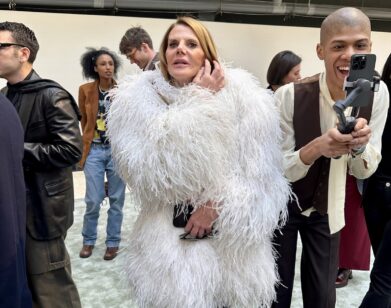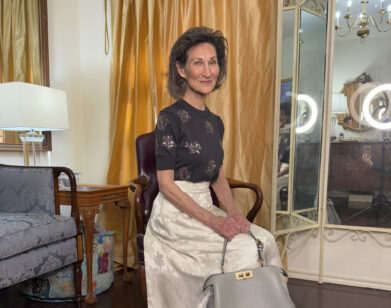Henrik Vibskov Is a Rock Star, Dresses Them

PHOTO BY MIKKEL BACHE
Designer Henrik Vibskov’s first American retail space, recently opened on Soho’s avant-garde-friendly Broome Street, is deceptively compact at 850 square feet. Fitting of the Danish maverick’s style, its neat and narrow interior is adventurous and multi-ranging in its scope. Of course, front and center are Vibskov’s own wacky wares, which gleefully defy staid Scandinavian stereotypes: his omnipresent colorful “Duy” knee socks are well-stocked, as are his sprightly fringed and raw-hemmed frocks and drop-crotch shorts for both men and women.
Vibskov’s distinctive off-beam designs provide the perfect pretext for collaborations, as well: he’s now an ambassador for eccentric Scandinavian brands. Interspersed throughout his boutique are a plethora of idiosyncratic styles from Cosmic Wonder, Stine Goya, Walter Van Beirendonck, and his friend Peter Jensen. Beyond its merchandise selections, the store’s décor reveals the intimacies of Vibskov’s inner universe; he has described the Broome Street interior, which features stylishly re-imagined Danish furniture, as reflecting both his own kitchen and bedroom—cherished personal spaces he regards as hubs of both comfort and creativity. And for Vibskov, who is equally comfortable on runways, galleries, and onstage—he would have been drumming for Trentemøller in New York City this weekend, had fatherhood duties not intervened—that ingenuity extends further than most.
A noted installation and multimedia artist who has presented at both MoMA/PS1 and MoMA, Vibskov channels all of his aesthetic capacities into terrifyingly inventive runway shows that often border on profane performance art. He describes his recent “Last Pier Performance” collection, presented in Paris, as a “blasphemous LSD trip.” Over the course of his ten-year career, in which he’s produced seventeen collections, other genre-shaking designers, such as Thom Browne, have taken a few cues from the Vibskov’s shock and awe presentation methods. More surprises are in store, he assures us—Spring 2012 will be a game-changer.
Nestled back in his studio space outside Copenhagen, Vibskov caught up with Interview to discuss making inroads into American fashion, his radically varying upcoming music and art projects, and why he’s relieved fashion is emerging from its Dark Age.
COLLEEN NIKA: You’ve finally erected your first American boutique in Manhattan. Why is the ideal time to do it?
HENRIK VIBSKOV: It might not be the right time, I just wanted to do it. [laughs] We sell to a handful of boutiques in New York anyway, but I always wanted to have my own space. A few factors came into place that made it possible this year. Why not now?
NIKA: Did you design the space yourself? What was the process?
VIBSKOV: I designed it myself, the same as I designed the previous retail spaces in Copenhagen and Olso. The inspiration for the interior is similar to those, as well. Of course, I also build sets for my shows and other personal projects, so I think about how to design “space” often. I also do a lot of installations for other companies, have done pop-up projects, so transforming environments the Vibskov way is always a fun challenge.
NIKA: Are you going to be doing design projects outside of fashion between seasons?
VIBSKOV: Yes, I’m actually working on a landscape for an exhibition on “Dutch Creativity” that is happening in Berlin this summer. I’m from Denmark, so I’m on the wrong side of the tracks, but there you go. [laughs] Also, I’m doing another installment of “The Fringe Project” [a textile-based performance series] with artist Andreas Emenius this summer in Holland.
NIKA: Are you a designer or artist first?
VIBSKOV: I would say I’m a musician first, actually. I started playing music when I was 10—I’ve been playing the drums for 28 years now! Then I started designing about 17 years ago, went to school, set up a proper business about 10 years ago—our anniversary coming up. But I’ve played music throughout and still am. I should be on tour in the US right now with Trentemøller as their drummer—but I became a dad.
NIKA: Does Trentemøller’s style reflect your own musical palette?
VIBSKOV: Well, if you know his music, you know it’s very electronic and programmed, almost rave-y. I love sequencing and programming, and I’m drawn to drum ‘n’ bass music. I love James Murphy’s productions—and hey, he wears my socks! But the other musical project I’m doing is radically different. I’m working with a poetry-based performance group called “Vi Sidder Bare Her” [translated: “Just Kind of Sitting Around”], with whom I’m doing a Scandi tour in May and June. Basically, my musical life is split between raving with drugged-up kids and reading obscure 75-year-old poetry, drinking very nice red wine with aged, graying men. [laughs]
NIKA: You missed Coachella to open your NYC boutique. Are you fan of Denmark’s own Roskilde, and musical festivals in general?
VIBSKOV: Of course. I love Pukkelpop, Lowlands, and Glastonbury. But Roskilde is great—it’s one of the things Danes try to be proud of. Actually, I usually try to set up a clothing pop-up shop at the festival every year. Working out how to do it this year. Who knows, maybe I’ll end up on stage, too!
NIKA: What’s your mindset for spring 2012?
VISBSKOV: I’m just working on some new ideas in the studio. New patterns, new color ideas. We make the patterns on the computer, but we also paint them by hand—it’s a combination of digital and screenprints. I’m trying to do as much as I can myself in the studio. I’m thinking about doing dusty colors—we definitely are doing as much color as we can. It seems that fashion is back on track with color—I hope. It’s been very black for awhile.
NIKA: Your designs definitely don’t fit the Scandinavian standard of grim monochromes.
VIBSKOV: No, I’m not really very Scandinavian in that way. I’m not a black, grey, beige type of guy. I was a kid on a playground that loved colors. But I can also do some dark-minded shit. [laughs]
NIKA: What inpires you?
VIBSKOV: Just by walking or sleeping, things hit you. Inspiration comes from everywhere. Western, Non-Western cultures—I’m open-minded. I love to travel. But not only for inspiration. Alas, timewise, I have a problem with that. Touring, museums, designing, babies.
NIKA: What are the unique advantages of growing up creative in Denmark?
VIBSKOV: Because we’re on the outside of everything, and we’re a small group of countries, we have a unique vantage point. We are extremely good at focusing our ideas into art and music and design that fits a global state of mind. Being observers of the rest of the world allows us to express something pure that goes beyond borders, beyond planets.
NIKA: What about disadvantages?
VIBSKOV: Well, because it so small, you can also feel limited and short-sighted. We may move our women’s show to New York City from Copenhagen. It might be nice to present to for a new crowd—that goes beyond a group of friends!
NIKA: How important is humor to fashion?
VIBSKOV: Very. Humor is a good way in general to get people together, I think. Of course, Danish humor is more ironic and sarcastic altogether.
NIKA: What’s a dream design project?
VIBSKOV: I think it would be cool to build some houses or something that could endure for more than 20 years. I had a dream about building a house on a dock, composed from 100 triangles. You’d have to sail from room to room. And maybe the entrance would be the mouth of a whale.
NIKA: What was your art school experience like?
VIBSKOV: I was educated in London [at Central Saint Martins] and had this whole thing about getting together with a lot of international students. Twenty-three languages were spoken during our lunch breaks! The school was very open minded, you could do whatever you wanted. Some people loved that freedom, others got lost. Gareth Pugh was a classmate, and so was Peter Jensen. The original Central St. Martins is moving its campus this year. I’ll be there for some lectures soon. I think the British government’s cutting back of arts funding is such a crime. I bet it will happen in Denmark soon, too.
NIKA: You just had a baby girl—congratulations. Do you hope she follows a creative path?
VIBSKOV: It’s up to her. I think all artists secretly hope their kids might do something safer and straitlaced: maybe she’ll be a banker. [laughs]






